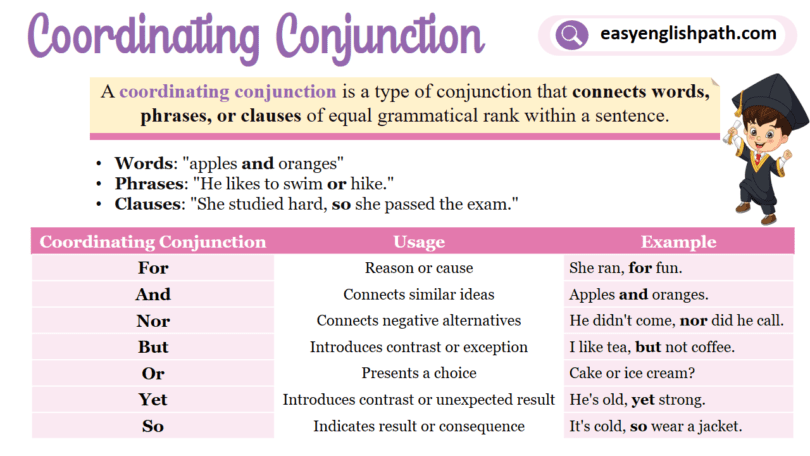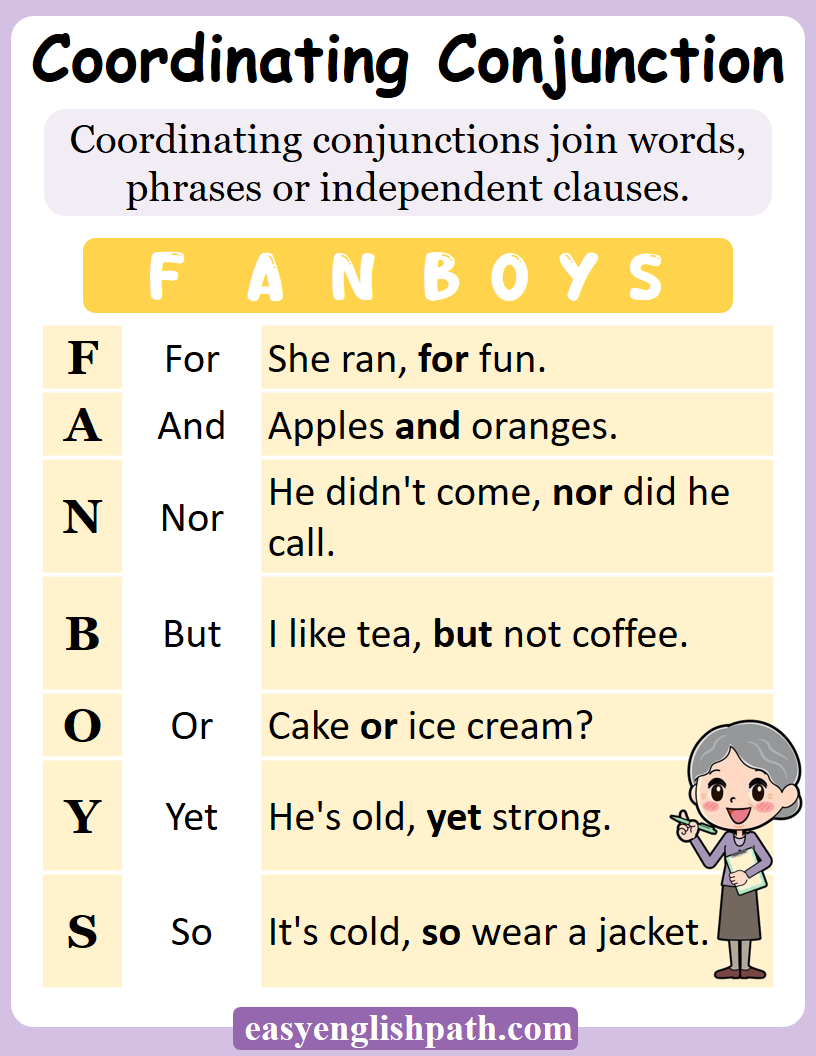Coordinating conjunctions are used to connect ideas and make sentences more interesting. Words like and, but, or, and so are coordinating conjunctions. These are the words that help us to put words together in a sentence. Coordinating conjunctions are important because they make our sentences clear.
What are Coordinating Conjunctions?
Coordinating conjunctions are words that connect words, phrases, or clauses. They join elements that are similar in structure and importance within a sentence.
- She was late for work due to traffic.
- She likes to read novels and magazines.
- He’s smart, but he’s lazy.
Seven Coordinating Conjunctions (FANBOYS)
The seven coordinating conjunctions can be remembered using the acronym FANBOYS:
- F – For
- A – And
- N – Nor
- B – But
- O – Or
- Y – Yet
- S – So
These conjunctions help connect words, phrases, and independent clauses to create clear and well-structured sentences.
Usages of Coordinating Conjunctions
- Joining Independent Clauses
- Joining Words or Phrases
- Joining Items In a List
- Joining Clauses in a Compound Predicate
- Joining Contrasting Ideas
- Expressing Cause and Effect
1. Joining Independent Clauses
Coordinating conjunctions are most commonly used to connect two independent clauses to form compound sentences.
- He ran, but he got tired.
- She sings, and he dances.
- She’s smart, yet she’s lazy.
2. Joining Words or Phrases
They can easily connect words or phrases of equal grammatical rank within a sentence.
- Tea or coffee?
- Pizza and salad.
- Tall but thin.
3. Joining Items in a List
Coordinating conjunctions can link items in a series or list.
- Pen, paper, and books.
- Soup, salad, or sandwich.
- Reading, writing, and drawing.
4. Joining Clauses in a Compound Predicate
They can join clauses that share the same subject, creating a compound predicate.
- He cooked and cleaned.
- She laughed but cried.
- They danced and sang.
5. Joining Contrasting Ideas
Coordinating conjunctions can also be used to express contrast or contradiction.
- Rich but unhappy.
- Tall yet graceful.
- Sunny but cold.
6. Expressing Cause and Effect
In some cases, coordinating conjunctions can indicate cause-and-effect relationships.
- He studied hard, so he passed.
- She exercised, so she’s fit.
- They worked late, so they finished.
Coordinating vs. Subordinating Conjunctions
| Feature | Coordinating Conjunctions | Subordinating Conjunctions |
|---|---|---|
| Purpose | Joins words, phrases, or independent clauses | Connects dependent and independent clauses |
| Example | He is tired, but he continues. | He continues although he is tired. |
| Sentence Structure | Links similar elements | Creates a dependent relationship |
Rules for Using Coordinating Conjunctions
1. Use a comma before a conjunction when joining independent clauses.
- She was tired, but she kept going.
2. Do not use a comma when connecting two words or phrases.
- He enjoys reading and writing.
3. Ensure the conjunction correctly conveys the intended meaning.
- He is tall, so he plays basketball (cause & effect).
4. Use coordinating conjunctions to maintain sentence clarity.
- Ali studied all night, so he passed.
5. Avoid unnecessary conjunctions to prevent redundancy.
❌ He went to the market and then he bought milk.
✅ He went to the market and bought milk.
Common Mistakes with Coordinating Conjunctions
1. Incorrect Use of “but” Instead of “so”
❌ He studied hard but he passed.
✅ He studied hard, so he passed.
2. Incorrect Use of “or” Instead of “and”
❌ She loves tea, or she drinks coffee every day.
✅ She loves tea, and she drinks coffee every day.
3. Incorrect Use of “yet” Instead of “so”
❌ Ahmad is tall, yet he likes basketball.
✅ Ahmad is tall, so he likes basketball.
Coordinating Conjunction Examples:
- He’s saving money for a trip to Europe.
- The restaurant serves pizza and pasta.
- She could neither hear the music nor see the stage from her seat.
- He’s talented, but he’s very modest about his skills.
- Should we go by car or take the bus?
- She studied hard, yet she failed the exam.
- She studied diligently, so she aced the test.
FAQs about Coordinating Conjunctions
1. What is the purpose of coordinating conjunctions?
They connect words, phrases, and clauses to form clear, structured sentences.
2. How many coordinating conjunctions are there?
There are seven: for, and, nor, but, or, yet, so (FANBOYS).
3. Can a sentence start with a coordinating conjunction?
Yes, in informal writing. Example:
✅ But he didn’t give up.
4. What is the difference between coordinating and subordinating conjunctions?
Coordinating conjunctions link similar elements, while subordinating conjunctions join dependent and independent clauses.
5. Why are coordinating conjunctions important?
They make sentences clear and engaging by connecting ideas properly.
You May Also Like this






